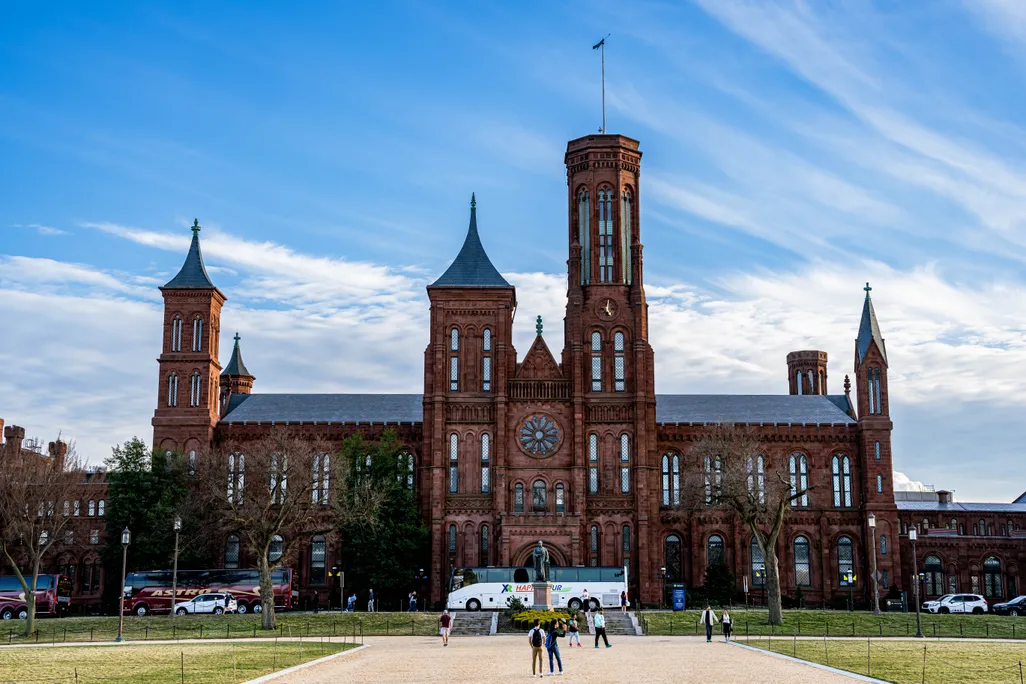
The First Presbyterian Church’s rare sandstone bricks will be transported to Washington, D.C., where they’ll be used to restore a 170-year-old Smithsonian building on the National Mall

Built in 1855 in the Gothic Revival style, the Smithsonian Castle is undergoing its first major renovation since the late 1960s.
Roy Rochlin / Getty Images
Rare sandstone bricks from a historic church in New Jersey will be used to renovate the Smithsonian Castle in Washington, D.C.
As construction crews demolish the First Presbyterian Church in Atlantic City, they’re carefully saving the red sandstone bricks lining its exterior, reports Amy S. Rosenberg for the Philadelphia Inquirer. The stones are destined for the National Mall, where they’ll be built into the original Smithsonian Institution building, also known as the Castle.
“The Castle restoration project will preserve it for the next 100 years,” Carly Bond, associate director of architectural history and historic preservation for the Smithsonian, tells Smithsonian magazine in a text. “The building is the symbolic heart of the institution.”
Built in 1855 in the Gothic Revival style, the Smithsonian Castle is undergoing its first major renovation in more than 50 years. The dark red Seneca sandstone covering the structure’s façade came from a Maryland quarry that shut down in 1901, so designers needed to find another source.
A member of the renovation team who is from Atlantic City suggested the First Presbyterian Church. When they brought a piece of sandstone from the Castle to the church, they realized it was a near-perfect match. The sandstone covering both structures came from the same geological formation.
Quick facts: The Smithsonian Castle’s rich history
- Built in 1855, the Castle is the Smithsonian’s oldest building.
- The structure was designed by architect James Renwick Jr., who won a national competition in 1846.
Built in 1867, the First Presbyterian Church was damaged when Hurricane Sandy swept through in 2012. The congregation using the building considered renovating it but eventually decided to move to another location. A nonprofit that provides meals to unhoused individuals also briefly used the space, but it had to move out when the building was deemed unsafe in 2019, as NJ Advance Media’s Eric Conklin reported last year.
Now, the 158-year-old church is being torn down to make way for a new marijuana dispensary. However, its red sandstone bricks will live on.
“Salvaging red sandstone from the demolition of First Presbyterian saves this material from a landfill, but it really saves the Castle,” says Bond.
Working while suspended off the ground by bucket trucks, crew members are painstakingly prying off each piece of stone by hand using chipper hammers.
The project is “so much more than a simple restoration,” SJ Hauck Construction, the company demolishing the church, wrote in a Facebook post last month. “We are literally helping preserve history, brick by brick.”
Once removed, the bricks are sent down a chute and packed onto flatbed trucks for the 200-mile journey to the nation’s capital. In Washington, they’re cut and carved to match the needs of the Castle, which was designed by American architect James Renwick Jr. The Smithsonian purchased all of the bricks from the First Presbyterian Church, and the institution’s leaders plan to save some for future use.
The Castle has been closed since February 2023 for extensive repairs and upgrades. The project, which is expected to take about five years, includes restoring the Great Hall to its original appearance; expanding and relocating the café, shop and restrooms; and creating a space for public programming.
Crews will also replace the windows, fix the roof and replace all of the mechanical, electrical, plumbing, safety, security and information technology systems. The last time the Castle underwent a major overhaul was in the late 1960s.
The 170-year-old structure has “mirrored the societal and institutional values of the time, for better or worse,” wrote Smithsonian Secretary Lonnie G. Bunch III for Smithsonian magazine in March 2023.
“The iconic red stone that makes up the building’s exterior is sandstone that was mined by enslaved people,” he added. Not long after the Castle opened, the American abolitionist Frederick Douglass was barred from speaking there because he was Black.
However, the Smithsonian has evolved—and so has the Castle, Bunch wrote. It’s now time for a makeover that honors and preserves the structure’s history while also bringing it into the modern era.
“After nearly two centuries, the Castle remains an embodiment of the heart of the Institution, a majestic space where the past and future converge,” Bunch wrote.

/https://tf-cmsv2-smithsonianmag-media.s3.amazonaws.com/accounts/headshot/SarahKuta.png)






